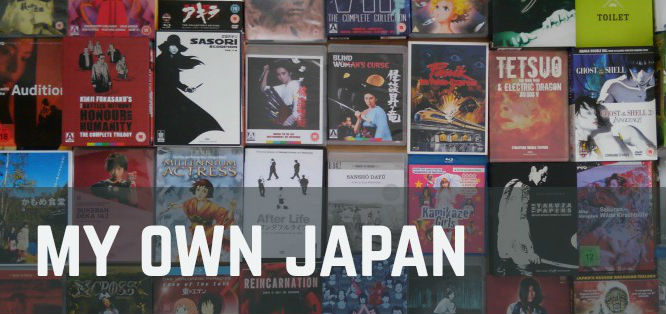
My Own Japan: Tough Love: Japanese Cinema and I
To say that I first came to Japan because of my love for Japanese cinema would be a major simplification. A gross exaggeration. Actually an outright lie. I first came to Japan, because my company needed someone to go to Japan. However, I’m sure my love for Japanese cinema played a part in my quick decision that I shall be the one, when my colleagues either couldn’t be bothered, or were taking too long to think it through.
Just now I hesitated to speak of ‘love’ while speaking of Japanese movies and myself. What I feel might well be love. But it’s the kind of love that can be cruel and painful and difficult. Buy me a beer, give me two minutes, and I will start whining about the sorry state of current Japanese cinema. Granted, there is the occasional award-worthy arthouse film, but what about the movies that really count? The ones that we will watch over and over again? The films that will become part of our own personal history, part of our DNA? Films that we actually love instead of just respectfully and dutifully admire? Sorry, but ‘Like Father, Like Son’ won’t do. I am talking about exciting multiplex blockbusters and inventive midnight b-movies. It seems Japan has given up on those.
Reading good comics because of bad movies
I first came to Japan in 1999, yet I didn’t start paying attention to theatrical releases here until several years later. Then the domestic box office was ruled by multi-part event movies like ‘20th Century Boys’ and ‘Death Note’. These two particular franchises I have to thank for one thing: They introduced me to their source material, manga masterpieces of the highest order. I’m no movie snob (believe it or not), I’m not much of a book snob, but I am a total comic and manga snob. Just ‘quite good’ is not good enough for me. I have been a fanatic reader of comic books in my childhood and youth, but I went cold turkey as a young adult, when my obsession became a financial liability. When I decided that I was grown-up and responsible enough to dip my toe into that world again, I was surprised how hard it was. It seemed like my former German teacher had finally gotten her revenge. She once barked at me, when I shyly trusted her with the information that I like sequential art, that she didn’t “even know how to read comics”. Finally I, too, somehow had lost the ability to put words and images into context. Of course, when my teacher bragged about her inability, she meant it as an insult to the medium. I saw my own inability as a compliment: This art form had become too sophisticated for me. The amount of concentration it took me as an adult to read comics took the fun out of it – unless the comics were really topnotch, best of the best, crowning achievements in arts and literature. Works like ‘20th Century Boys’ and ‘Death Note’. ‘20th Century Boys’ made me feel like a teenager again, feverishly sucking up giant tomes of Stephen King about the eternal struggle between childhood trauma and childhood nostalgia. ‘Death Note’ kept me up night after night with its quick pace, endless twists, ambiguous characters and complex takes on morality.
But the movies? Oh, sweet Jesus. I really tried to like them. I tried several times. Alas, I never made it much further than the middle mark. As isolated events, two lame movie adaptations wouldn’t be a big deal. Unfortunately, these cases are symptomatic of modern Japanese mainstream cinema. Year after year the industry follows that same principle, churning out overlong, underwritten, poorly made, flavorlessly directed manga adaptations (or live-action remakes of nostalgic anime, or relaunches of classic film franchises). Too complex for the uninitiated, not complex enough for the die-hard fans, heinously miscast courtesy of the crime-syndicate-like talent agencies that have been successfully keeping the Japanese entertainment industry free of actual talent for decades. (Not saying there is no actual talent here, just saying look for it elsewhere than Johnny’s.)
And what about those lean and mean b-pictures that the true connoisseur prefers over blockbuster slickness anyway? Don’t get me started. Oh, I guess it’s too late, I already got myself started. If I have to watch just one more of those ‘Zombie Schoolgirls vs. RoboGeisha’ flicks, my eyeballs will pop out like so many eyeballs in those movies. They were mildly amusing when it all started, but I can’t believe they are still getting made. Obviously they are mainly getting made for overseas markets (often with overseas money), so adolescent western movie buffs may chuckle about those “whacky Japanese”.
In other words: Adolescent western movie buffs like I once was. In the 1980s, films like Sogo Ishii’s satirical comedy ‘The Crazy Family’ or Shinya Tsukamoto’s Kafka/cyberpunk mash-up ‘Tetsuo: The Iron Man’ were staples in Germany’s arthouse cinemas, and they had me assume that those Japanese must be rather whacky indeed. Today I know, of course, that the Japanese in general are not whackier than any other civilized society, they just have a healthy number of stand-out whacky artists, like any civilized society should have.

Travels with Tetsuo
I have recently revisited ‘Tetsuo’ and ‘The Crazy Family’, and I was pleasantly surprised how well both have aged. Tetsuo’s no-budget special effects, hammering industrial soundtrack, unwholesome imagery, crazy camera and editing are as bewildering and exciting today as they were in 1989. Every single aspect of ‘The Crazy Family’ might as well be a dead-on commentary on current Japanese society as it was more than 30 years ago.
My personal history with the three Tetsuo films is also my personal history of literally expanding my horizon. The first one I saw at a cinema in my hometown of Bremen, Germany. The second one I bought on videotape during a trip to London. The film turned out to be an interesting failure. At the time I thought the worst thing about it was that it was shot in color – such a sell-out, this Tsukamoto fellow. When the third one came out in 2010, I had finally arrived: I could watch it at Shibuya’s esteemed Cinema Rise (myself being one of two or three paying customers that afternoon). The film wasn’t especially good, but it also wasn’t as horrible as some people made it out to be, after pushing their own expectations to unreachable heights over almost 20 years of anticipation. Shinya Tsukamoto has remained one of the most interesting directors to come out at a time when the glory years of Japanese cinema were long over (not that I was aware of it then). I enjoyed the outlandish eroticism of ‘A Snake of June’ as much as I enjoyed the more conventional J-horror scares of his ‘Nightmare Detective’ movies (selling out is not that big a deal to me anymore – we have all been there). I am even looking forward to his ‘Untitled Samurai Film’, even though I’m not big on period pieces (not as long as the period is pre-1950s). Tsukamoto reenacting his punk rock days in middle age for another Tetsuo film was bound to become not much more than a half-hearted offering of fan service. The man has moved on, as his fans should.
Not myself, though. I rather move backwards. Even further back than Tsukamoto’s early career.
Loving the scorpion
 When I mention Meiko Kaji, my Japanese wife thinks of the older lady who plays tough moms on TV. To me, however, Kaji will always be the embodiment of dangerous, youthful sex appeal that was rampant in Japanese cinema in the glorious 60s and 70s. To me, Meiko Kaji will always be Sasori, also known as ‘Female Prisoner #701: Scorpion’. The series of four films about deadly, almost silent Nami (nicknamed Scorpion; Sasori in Japanese) exacting revenge on the cops that wronged her, and on the prison wardens that wronged her some more, is a shining example of everything that was great about Japanese cinema in the 70s. Oh, it was a time of despair, officially. More and more people were rather staying home and watching television instead of going to the movies. So studios let go of all artistic ambition and gave the people what they thought they wanted: formulaic genre offerings. At least that was the plan. However, the directors making those cheap and presumably simple exploitation movies often did have artistic ambitions of their own. If they couldn’t make use of them in art films, they would make use of them in yakuza thrillers, or soft porn, or female prison revenge dramas (which can be a bit of both). The studios didn’t care, as long as the product was ready in time and carried a girl, a gun, or both on the poster.
When I mention Meiko Kaji, my Japanese wife thinks of the older lady who plays tough moms on TV. To me, however, Kaji will always be the embodiment of dangerous, youthful sex appeal that was rampant in Japanese cinema in the glorious 60s and 70s. To me, Meiko Kaji will always be Sasori, also known as ‘Female Prisoner #701: Scorpion’. The series of four films about deadly, almost silent Nami (nicknamed Scorpion; Sasori in Japanese) exacting revenge on the cops that wronged her, and on the prison wardens that wronged her some more, is a shining example of everything that was great about Japanese cinema in the 70s. Oh, it was a time of despair, officially. More and more people were rather staying home and watching television instead of going to the movies. So studios let go of all artistic ambition and gave the people what they thought they wanted: formulaic genre offerings. At least that was the plan. However, the directors making those cheap and presumably simple exploitation movies often did have artistic ambitions of their own. If they couldn’t make use of them in art films, they would make use of them in yakuza thrillers, or soft porn, or female prison revenge dramas (which can be a bit of both). The studios didn’t care, as long as the product was ready in time and carried a girl, a gun, or both on the poster.
The Sasori films are entirely unique, incomparable, unforgettable masterworks, with their inventive use of abstract sets, unreal lighting, fairy-tale elements, stories within stories, envelope-pushing cruelty and violence, over-the-top political and sexual allegory, Kaji’s silent-era movie star qualities, and the haunting ballads she sang for the soundtracks. No disrespect to Kurosawa or Ozu, but these films deserve to come out on top the next time somebody important compiles a list of the Best Japanese Films Ever.
It has to be said that Meiko Kaji is perfectly capable of delivering dialog; playing Nami almost mute was more a testament to her ability as an actor than an indication to the contrary. It also should be pointed out that she has played many other iconic roles, most notably perhaps the titular lady from the ‘Lady Snowblood’ saga. I liked Lady Snowblood. But I fell for Sasori.
There is a sad irony to the fact that I still have to consummate my love for Japanese cinema through DVD and Blu-ray releases from mainly European distributors, even though I live in Japan now. Domestic Japanese releases often are rather bare-bone, yet are priced as if the discs were made of pure gold. Also, a lot of the very best stuff simply remains unreleased in its origin country. Instead of properly honoring and preserving their own heritage, it seems Japanese studios are too busy cranking out ever more pointless ‘Death Note’ spin-offs, prequels, reimaginations, crossovers.
Count me out. I’ll keep living in the past. And by now I’m old enough to not feel bad about it.




